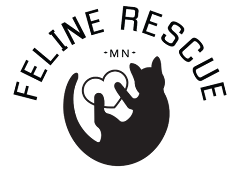Our dedicated Outreach volunteers actively participate in spay and neuter advocacy in the community and cat retention program efforts including connecting cat owners with resources and providing access to litter, food, and other necessary cat supplies to enable cats to remain with their families. We offer low-cost alternatives to those who might not otherwise have the funds to alter cats. In addition, we work with the community and with other local rescue groups to prevent increases to the feral cat population. Last year, our Outreach volunteers assisted with the spay/neutering of 1045 cats, with 424 surgeries in the third quarter alone.
Feline Rescue’s Outreach Program will surpass subsidizing 10,000 spay/neuter surgeries this year.

Here's a story that illustrates the community need and how Feline Rescue’s Outreach Program helps facilitate spay and neuter surgeries.
Working together to save cats
By Kari CedergrenSITUATION
In May 2016, my realtor and friend, Rebecca from Cartwright Realty contacted me about a property her clients wanted to buy. But there was an issue. Rebecca’s clients would not close on the property unless the community of accumulated cats were removed. The selling realtor was supposed to “take care” of the animals, but had not. With only weeks left until closing, Rebecca took matters into her own hands. She estimated there were 50 cats in this colony that needed homes … and fast. As an animal lover, volunteer, and sustaining patron of the Tri-County Humane Society and Minnesota Horse Welfare Coalition, I wanted to help my friend, Rebecca and save some feline lives.
SAINTLY CITIZEN
A saintly soul, Susan, the property’s owner, loved her outdoor cats. She built shelters for them in old sheds and filled them with mattresses, blankets, and straw. She housed and fed her furry friends and they were fruitful and multiplied. Susan never considered what might happen when she was no longer able to care for herself. She was moved into a nursing home, leaving her community of cats to fend for themselves.
A SOLUTION
The situation was out of control. Rebecca caught most of the cats and placed them with various humane agencies. Thankfully there are local organizations to help concerned citizens do what is best for unwanted animals. Tri-County Humane Society (TCHS) led by Vicki Davis, Executive Director does incredible work in the Saint Cloud community. Their building is small but they help the same number of animals as institutions twice their size. Through a few phone calls and some coordination, TCHS helped with the majority of Susan’s cats. The kittens and a few more of the friendlier cats were adopted out as house cats and a large number were placed through TCHS’ Barn Cat program. The Barn Cat program places cats that are unfit to live indoors for various reasons. These cats are fixed. They go on to live fruitful lives but do not multiply.
THE COSTS
There are costs to fix animals. I wanted to find a way to help cover some of TCHS’ costs for fixing Susan’s cats. Feline Rescue in Saint Paul is a nonprofit that operates three Programs: Shelter (Adoption), Foster (Adoption), and Outreach. The focus of the Outreach Program is to help concerned citizens cover some of the costs associated with Trapping, Neutering, and Returning (TNR) outdoor cats back into the community and to coordinate resources for members of the community needing veterinary care, food, or other resources for their cats. The Outreach Program of Feline Rescue is supported by donations, grants, and volunteer hours. Grant money the Outreach Program received from Chuck & Don’s Pet Food & Supplies earlier this year was used to help cover a portion of the cost of fixing Susan’s cats.
CALL TO ACTION
25 years ago these animals would have been destroyed. Thanks to the dedication of the Tri-County Humane Society and the willingness of the Outreach Program at Feline Rescue to share their grant money from Chuck & Don’s Pet Food & Supplies, Susan’s cats are now enjoying life in their new locations. These 50 cats represent a much bigger problem in the State of Minnesota, however. There are many, many more cat colonies that are being fed by concerned citizens like Susan, and the task of Trapping, Neutering, and Returning them - or better yet, finding them indoor homes - is a large one.
Through awareness, concerned citizens now have more humane options for handling outdoor cats. We need you to continue this work.
Donate to the Trap Neuter Return (TNR) program for community cats through Feline Rescue’s Outreach Program by visiting FelineRescue.org/Donate-Now. Please designate your donation to ‘Outreach Program’.






























